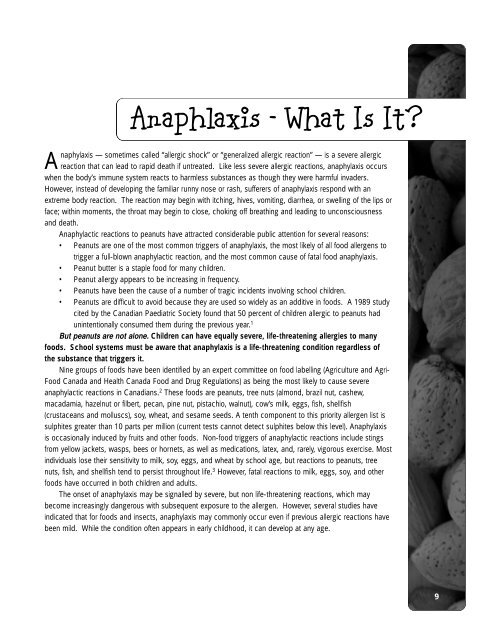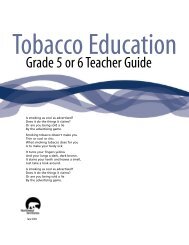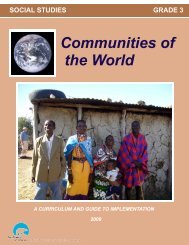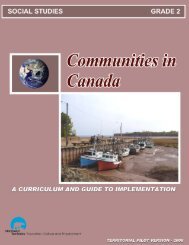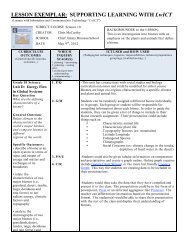Anaphylaxis: A Handbook for School Boards - Education, Culture ...
Anaphylaxis: A Handbook for School Boards - Education, Culture ...
Anaphylaxis: A Handbook for School Boards - Education, Culture ...
Create successful ePaper yourself
Turn your PDF publications into a flip-book with our unique Google optimized e-Paper software.
Anaphlaxis - What Is It?<strong>Anaphylaxis</strong> — sometimes called “allergic shock” or “generalized allergic reaction” — is a severe allergicreaction that can lead to rapid death if untreated. Like less severe allergic reactions, anaphylaxis occurswhen the body’s immune system reacts to harmless substances as though they were harmful invaders.However, instead of developing the familiar runny nose or rash, sufferers of anaphylaxis respond with anextreme body reaction. The reaction may begin with itching, hives, vomiting, diarrhea, or swelling of the lips orface; within moments, the throat may begin to close, choking off breathing and leading to unconsciousnessand death.Anaphylactic reactions to peanuts have attracted considerable public attention <strong>for</strong> several reasons:• Peanuts are one of the most common triggers of anaphylaxis, the most likely of all food allergens totrigger a full-blown anaphylactic reaction, and the most common cause of fatal food anaphylaxis.• Peanut butter is a staple food <strong>for</strong> many children.• Peanut allergy appears to be increasing in frequency.• Peanuts have been the cause of a number of tragic incidents involving school children.• Peanuts are difficult to avoid because they are used so widely as an additive in foods. A 1989 studycited by the Canadian Paediatric Society found that 50 percent of children allergic to peanuts hadunintentionally consumed them during the previous year. 1But peanuts are not alone. Children can have equally severe, life-threatening allergies to manyfoods. <strong>School</strong> systems must be aware that anaphylaxis is a life-threatening condition regardless ofthe substance that triggers it.Nine groups of foods have been identified by an expert committee on food labelling (Agriculture and Agri-Food Canada and Health Canada Food and Drug Regulations) as being the most likely to cause severeanaphylactic reactions in Canadians. 2 These foods are peanuts, tree nuts (almond, brazil nut, cashew,macadamia, hazelnut or filbert, pecan, pine nut, pistachio, walnut), cow’s milk, eggs, fish, shellfish(crustaceans and molluscs), soy, wheat, and sesame seeds. A tenth component to this priority allergen list issulphites greater than 10 parts per million (current tests cannot detect sulphites below this level). <strong>Anaphylaxis</strong>is occasionally induced by fruits and other foods. Non-food triggers of anaphylactic reactions include stingsfrom yellow jackets, wasps, bees or hornets, as well as medications, latex, and, rarely, vigorous exercise. Mostindividuals lose their sensitivity to milk, soy, eggs, and wheat by school age, but reactions to peanuts, treenuts, fish, and shellfish tend to persist throughout life. 3 However, fatal reactions to milk, eggs, soy, and otherfoods have occurred in both children and adults.The onset of anaphylaxis may be signalled by severe, but non life-threatening reactions, which maybecome increasingly dangerous with subsequent exposure to the allergen. However, several studies haveindicated that <strong>for</strong> foods and insects, anaphylaxis may commonly occur even if previous allergic reactions havebeen mild. While the condition often appears in early childhood, it can develop at any age.9


